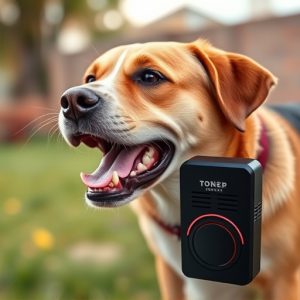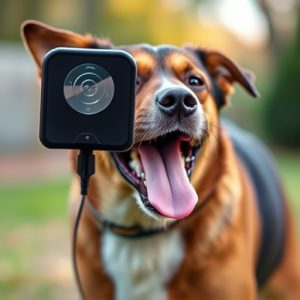Electronic Dog Barriers: Effective Yard Coverage Solutions for Neighborhood Control
Neighborhood dog control utilizes electronic dog barriers with yard coverage to manage canine behavi…….
Neighborhood dog control utilizes electronic dog barriers with yard coverage to manage canine behavior in public spaces, addressing issues like excessive barking and territorial aggression. These sonic fences emit harmless high-frequency sound waves that irritate dogs, promoting responsible pet ownership and enhancing residents' quality of life. When choosing a barrier, prioritize yard coverage, adjustable range, high-quality sound projection, and customizable sound levels, with eco-friendly options preferred. Proper installation, regular maintenance, and adherence to safety guidelines ensure optimal effectiveness and safety.
Neighborhood dog control has become an increasingly important aspect of community living. In this digital age, sonic equipment offers an innovative solution with electronic dog barriers designed for effective yard coverage. This comprehensive guide explores how these barriers can mitigate canine-related issues while promoting harmonious coexistence within neighborhoods. We’ll delve into the benefits, functionality, and key features to consider when choosing the right sonic device. Additionally, installation, maintenance, and safety guidelines will ensure successful implementation.
- Understanding Neighborhood Dog Control and Its Benefits
- How Electronic Dog Barriers Work for Effective Yard Coverage
- Key Features to Consider in Choosing the Right Sonic Equipment
- Installation, Maintenance, and Safety Guidelines for a Successful Implementation
Understanding Neighborhood Dog Control and Its Benefits
Neighborhood dog control, often implemented through sonic equipment, is a community-based approach to managing canine behavior in public spaces. This method utilizes electronic dog barriers designed to cover specific yard areas, creating a safe and peaceful environment for residents. By employing these advanced technologies, communities can mitigate issues like excessive barking, territorial aggression, and stray dog incursions, fostering better coexistence between pets and their neighbors.
The benefits of such control measures are multifaceted. They promote better pet ownership, ensuring dogs receive proper training and socialization while encouraging responsible behavior. Moreover, they enhance the overall quality of life for residents, providing a quieter and safer outdoor experience. With effective yard coverage, electronic dog barriers can significantly reduce conflicts between pets, promoting a more harmonious neighborhood.
How Electronic Dog Barriers Work for Effective Yard Coverage
Electronic dog barriers, also known as sonic fences, are innovative solutions for effective yard coverage and pet control. These devices operate by emitting a high-frequency sound wave that is inaudible to humans but irritating to dogs. When a dog enters the barrier’s range, the device triggers, emitting this sound signal, which discourages the animal from proceeding further into the restricted area. This technology is highly effective as it not only prevents dogs from straying but also promotes good behavior and training by associating certain areas as off-limits.
The key to their success lies in the comprehensive yard coverage they offer. These barriers can be customized to fit various fence types, ensuring that every corner of the yard is accounted for. The electronic signals have a certain range, allowing pet owners to define specific boundaries within their properties, keeping dogs secure while still allowing them access to other areas for exercise and exploration. This level of control is particularly beneficial for homeowners who want to keep their pets safe without compromising on outdoor space.
Key Features to Consider in Choosing the Right Sonic Equipment
When selecting the appropriate sonic equipment for neighborhood dog control, several key features should guide your decision to ensure effectiveness and efficiency. Firstly, consider the yard coverage offered by the device. The ideal electronic dog barrier should encompass your entire property, deterring dogs from entering unwanted areas. Look for models with adjustable ranges to tailor the barrier to different-sized yards.
Additionally, the sound quality and projection are vital. High-quality equipment produces clear, effective sounds that can be heard distinctly over a wide area. Some devices offer adjustable sound levels, allowing you to customize the intensity based on your preferences and local regulations. Remember to consider power sources; rechargeable batteries or solar panels can be more environmentally friendly and convenient than traditional cords.
Installation, Maintenance, and Safety Guidelines for a Successful Implementation
When implementing a neighborhood dog control system using electronic dog barriers, proper installation and regular maintenance are key to ensuring its effectiveness and safety. First, select a barrier system that covers the desired yard area adequately. Check the product specifications for range and frequency to guarantee it will encompass your entire property without gaps. Once installed, ensure all components are secure and properly grounded to avoid electrical hazards.
Regular upkeep is vital too. Keep the equipment clean, free from debris, and regularly inspect connections for any signs of wear or damage. Test the system periodically to ensure reliable operation, especially before and after changing seasons when environmental conditions might impact performance. Always follow safety guidelines, such as using protective gear during installation and ensuring proper voltage levels to prevent accidents or equipment malfunctions.
Neighborhood dog control through electronic barriers offers an effective solution for managing canine activity in shared spaces. By providing robust yard coverage, these devices help maintain peace and harmony among residents while ensuring the safety and well-being of local dogs. When selecting the right equipment, consider key features like frequency range, power output, and customizable settings to match your specific needs. Proper installation, regular maintenance, and adherence to safety guidelines are essential for a successful implementation that benefits both pets and their communities.


